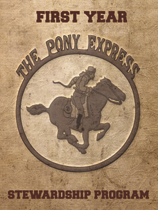
PONY EXPRESS
1ST YEAR PLAN

THE PONY EXPRESS STEWARDSHIP PLAN
History Of The Pony Express
More than a century ago, mail was carried westward by The Pony Express. The success of this exciting venture was based on the team work of a number of route riders--daring men who sped on horseback from one station to another, relaying to fresh riders their mail-filled saddlebags.
The Program of Proven Success
Pastors and financial stewardship officials across North America and beyond have been using The Pony Express Stewardship Plan to conduct highly successful budget campaigns. Through 1998 it has produced impressive results in more than 20,000 churches of all sizes and many denominations in cities large and small. The program is so adaptable that it works equally well in churches ranging in membership from many thousands to less than 100! You can easily tailor it to meet your particular needs.
By using this dynamic system several years in succession, as most churches do, many have been able to achieve an orderly increase in income of from 10% to 20% per year.
Here's How The Popular Relay System Works
Prior to the solicitation of financial commitments, members who are mobile are divided into ten-houshold "Pony Express Run" routes. A special saddlebag is prepared for each route. It contains financial stewardship reading material as well as unsealed enclosure envelopes containing "estimate of giving" cards. Attached to the saddlebag strap is a list showing the names, street addresses and phone numbers of the route families and the "trail boss" recruited and trained to supervise the bag relay from home to home.
After the noon hour on the Sunday you designate, the trail bosses and their families start the Pony Express Run by sitting down in their homes and carefully digesting the motivational stewardship reading booklet. Then, each prayerfully fills in their estimated giving during the coming year, stewardship booklet is returned to the pouch from which it was removed. Next, the saddlebag is hurried on to the second household on the route list.
This second household repeats the process and then, within 24 hours, delivers the saddlebag to the third one for it's use. Returning home, this delivering "route rider" household reports by phone to the trail boss that the bag has been handed to a responsible member of the receiving household. After the last one on the route has used the bag, it is relayed back to the trail boss-- who delivers to the church office the "church mail" it contains.
Route-assigned households who were "missed" during the Run are sent letters with estimate of giving cards and return envelopes enclosed. They agree urged to respond without delay, ahead of the Sunday on which the summary report of the results of the campaign is made.
Prior to the Run, alert homebound members and members too scattered to have been placed on neighborhood routes will have received in the mail their estimate cards and return envelopes--with the invitation to let their postal carrier assist them in participating in their church's campaign. Or, as an option, special routes will have been created the these persons, with trail bosses recruited to relay the bags on for them.
What--No Pledge Cards?
That's right! The Pony Express Plan does not ask members to sign pledge cards. Nor does it call for "officials from the church" to call on members seeking their financial commitments. Part of the magic of this different approach is that it "wires around" the objections many members have to "signing a pledge."
Using the Pony Express method, members are invited to simply fill in the amount they "estimate" they will contribute to their church during the coming year. (The name and address of the member will have already been entered on the card.) The much-appreciated setting in which the card is filled in is the privacy of the member's home--without any "over-the-shoulder" supervision of church "officials."
Do Church Members Pay Their Estimates?
Yes! They nearly always maintain the level of giving required to meet or exceed their giving estimates. They seldom need more than a note now and then thanking them for their financial stewardship and enclosing a report of their giving and the estimate they made. Using this approach to secure estimates consistently produces higher results than traditional approaches used to secure pledges.
Why Does The "Estimate of Giving" Concept Work So Well?
It probably has a lot to do with the fact that members receive a strong vote of confidence from their pastor, who is responsible for presenting the scriptural basis for financial resources In effect, the pastor and these stewardship leaders say by their actions, "We trust you to love God and care about funding the ministry of Jesus Christ, just as we do." Members are very much aware of this positive attitude toward them. And they very often demonstrate their gratitude with renewed and increased giving!
Home Contact Order Info Books Guarantee Next